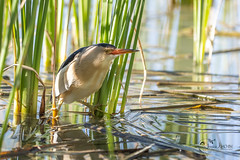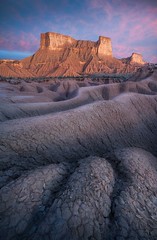
Sri Lankan Kangaroo Lizard -(Otocryptis wiegmanni) is a small, grounddwelling agamid lizard endemic to the wet zone forests and lower mountain forests (up to 1300 meters) of Sri Lanka.This lizard when disturbed may run bipedally (Rises on to its hind legs when running). That is the base for unusual name ‘kangaroo lizard’ for it. It is commonly seen in the leaf litter near forest streams of shady rain forests.
It is commonly found in wet and intermediate zone habitats and is rarely seen in the dry zone except in riverine habitats. It is not found in highly populated areas.This lizard is active during the daytime and it is commonly found in pairs. It feeds on small insects and uses its hind legs to run, especially when threatened. It is usually found on tree trunks in the afternoon and under large leaves at night. This lizard leads a semi-arboreal life. When perceiving danger, it spurts away quickly on its large hind legs and might eventually climb up a sapling or tree. It feeds on small insects, grubs and tender shoots. It is closely related to the Indian Kangaroo Lizard (Otocryptis beddomii) of the rain forests of South India.
Adult body size,about 7 cms. Tail: 15 cms. Its colour ranges from dark reddish brown to dull brown. Males are darker than females. Lays between three and five eggs in a nest in the ground between July and January. Its diet consists of insects (Ants, Moths, Grasshoppers and Beetles), Spiders and occasionally plant materials such as tender shoots.
This lizard also called Wiegmann’s Agama or Brown-patched Kangaroo lizard ,several Sinhalese names for this lizard – Kala Katussa, Yak Katussa, Pinum Katussa, Thalli Katussa
Tags: Brown-patched Kangaroo lizard, Dry zone kangaroo lizard, Endemic, Endemic Lizard, Iguana, kala katussa, Kangaroo Lizard, Otocryptis weigmanni, pinum katussa, Reptiles, Sri Lankan Kangaroo Lizard, Thalli katussa, wet zone kangaroo lizard, Wiegmann's Agama, yak katussa

Asian Groundling is a Very common dragonfly in Sri Lanka. Abdomen – 19-20mm and Wings – 22-23mm. wings 22-23mm. Female is lighter in color and much yellowish with clear wings contrary to male figured above. Habitats are slow flowing streams, weedy tank edges and marshes from the sea level to mid-hills.
The Asian Groundling males look really good with orange colouration to their wings.Their thorax and abdomen change colour slightly as it ages, from light brown to a more deep orange. The females are very similar to the males, yet they have colourless wings and their thorax and abdomen is a yellow/brown. The females become darker brown as they age.Common names of Brachythemis contaminate are Ditch Jewel, Asian Groundling, Asian Amberwing, Orange Skimmer, Common Amberwing
If you ever visit a pond, ditch or bucket of water in Sri Lanka you are sure to come across this species. They even like to follow you as you walk and hover in front of you. Asian Groundling Can be seen all year, everywhere in the lowlands and many uplands places too.
Tags: Asian Amberwing, Asian Dragonflies, Asian Groundling, Asian Groundling female, Asian Groundling male, Brachythemis contaminate, Common Amberwing, Ditch Jewel, Dragonfly, Insects, Odonata, Orange Skimmer, Sri Lanka dragonflies


An endemic damselfly of Sri Lanka found near forest streams and rivers from lower hills to montane areas.
It is common and often found together with
Oriental Green-Wing and Shining Gossamerwing.
A male with black-tipps to wings.Both male and female have very shining colors.
I have captured this couple in Padukka,Sri Lanka
Tags: Bio diversity Sri Lanka, Black-tipped Flashwing, Black-tipped Flashwing female, Black-tipped Flashwing male, damselfly, Dragonfly, Endemic, Endemic Damselflies, Endemic dragonflies, Insects, Odonata, pterigota, Sri Lanka damselflies, Sri Lanka dragonflies, vestalis apicalis nigrescens, zygoptera

Paddyfield Parasol female is very similar to the young male. The black dorsal lines are thicker than the males and the terminal segments are generally darker. The colour at the base of the wings is generally much less prominent.
The adult male is easily identifiable,but not common. It is generally orange/yellow in colour and different from the female.
Paddyfield Parasol can be seen in many places from open wasteland to the edge of forests,paddy fields and can be Found in Asia; Sri Lanka ,Bangladesh, China, Hainan, India, Myanmar, Malaysia, Peninsular Malaysia
Tags: Anisoptera, Asia dragonflies, China dragonflies, damselfly, Epiprocta, Insects, Neurothemis intermedia, Odonata, Paddyfield Parasol, Sri Lanka damselflies, Sri Lanka dragonfly, zygoptera

Erebus ephesperis is a moth of the Noctuidae family. It is found in Asia, including Sri Lanka ,India,Japan, the Korean Peninsula, China, Singapore and Borneo.
The wingspan is about 90 mm and the patterning is very obliterative, breaking the body outline with shadow like countershading.Adults feed on fruit juice, including peach.
In the adult moth Careful examination of its underside revealed that the moth is a male, possessing both retinaculum and frenulum near the wing bases .
I have captured this dorasl view of Erebus ephesperis at Kalutara,Sri Lanka on the night of 24th July 2012.
Tags: Arthropoda, Asia moths, Borneo moths, china moths, Erebus ephesperis, Indian moths, Insects, Japan moths, korean moths, Moths, Moths Sri Lanka, night moths, Noctuidae family, Sri Lanka Moths
The Green Skimmer is also known as the Green Marsh Hawk and can be found in parts of Africa, Australia and Asia including Sri Lanka . Both sexes are similar in appearance and can be identified by the shape of the abdomen, dilated first three segments and the alternating yellow-green and black pattern.The extraordinary swollen abdomen of this dragonfly is remarkable and a useful identification feature of it.
It is a very common dragonfly in Sri Lanka and can be found around tanks, ponds, irrigation channels and rice fields. It’s range covers the low country and extends up into the hills.
Tags: Africa, Anisoptera, Australia, Dragonflies, Epiprocta, Green Marsh Hawk, Green Skimmer, Insects, Odonata, Orthetrum sabina sabina, pterigota, Sri Lanka dragonfly

These spiders make certain zig-zag pattern on web therefore also known as writer or signature spider.This spider weaves four zig zag stripes in its web, and holds its legs together in pairs. It holds its legs in pairs to disguise itself as a four legged creature; it does this to not appear to look like a spider.
These spiders have many names around the world, they are known as an Argiope, a Black and Yellow Garden Spider or a Writing Spider in North America. It is known as Wasp Spider in Germany and the rest of Europe and the St Andrews Cross spider in Austrailia. They know it as KOGANE-GUMO in Japan and east asia. There are 75 different species of this spider but they all look the same. Their colours vary in between their stripes but they all keep the black and yellow stripes, They distribute also Sri Lanka, Maldives,India, Pakistan.Their habitats are Moist Deciduous forests in the sunny parts.
They build their web only about a meter off the ground to catch the low flying insects such as bees and wasps that travel from flower to flower. Their web is almost invisiable, only for the zig zag strips on the web you wouldnt see it. These zig zag strips are known as the stabilmentum, they form these strips to warn bigger animals of its location, so they wont destroy it by walking through it.
When they have the web built, they line up their legs with the white strips of zig zaging silk. The centre of the web is hollow and this is where the spider sits. They group their legs together to appear as a four legged creature but also for another reason. When their legs are together, their hairs on their legs intertwine and act as a sun reflector along with the bright white X in its web. They do this because they know bright colours attract insects such as bees and wasps. Their legs reflect the sun and with their brightly coloured body they fool the insects into thinking they are flowers
Most of these spiders the male is much smaller than the female, Female: 8-12 mm;and Male: 3.5-4.5 mm.and after mating the female will kill the male. The male spins a web along side the females web known as a companion web, after mating the female will lay her eggs onto this companion web and wrap them up into a sac. Spiders are canabals and they eat each other to stay alive in the sac until they are strong enough to break through the sac walls.
Signature spiders are able to eat an insect twice its size, and this is all they eat.

Tags: Aracnida, Argiope, Argiope anasuja, athropoda, Australia spiders, Black and Yellow Garden Spide, female kill the male, India, KOGANE-GUMO, KOGANE-GUMO Japan, Maldives, Pakistan, Signature spider, spiders, sri Lanka spiders, St Andrews Cross spider, Wasp Spider, Wasp Spider Germany, Writing spider, Writing Spider in North America













